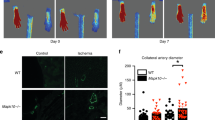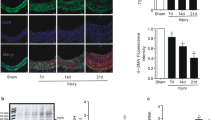Abstract
Balloon angioplasty disrupts the protective endothelial lining of the arterial wall, rendering arteries susceptible to thrombosis and intimal thickening. We show here that vascular endothelial growth factor (VEGF), an endothelial cell mitogen, is upregulated in medial smooth muscle cells of the arterial wall in response to balloon injury. Both protein kinase C (PKC) and tyrosine kinase pp60src mediate augmented VEGF expression. In contrast, nitric oxide (NO) donors inhibit PKC-induced VEGF upregulation by interfering with binding of the transcription factor activator protein-1 (AP-1) to the VEGF promoter. Inhibition of VEGF promoter activation suggests that NO secreted by a restored endothelium functions as the negative feedback mechanism that downregulates VEGF expression to basal levels. Administration of a neutralizing VEGF antibody impaired reendothelialization following balloon injury performed in vivo. These findings establish a reciprocal relation between VEGF and NO in the endogenous regulation of endothelial integrity following arterial injury.
This is a preview of subscription content, access via your institution
Access options
Subscribe to this journal
Receive 12 print issues and online access
$209.00 per year
only $17.42 per issue
Buy this article
- Purchase on Springer Link
- Instant access to full article PDF
Prices may be subject to local taxes which are calculated during checkout
Similar content being viewed by others
References
Ferrara, N. & Henzel, W.J. Pituitary follicular cells secrete a novel heparin-binding growth factor specific for vascular endothelial cells. Biochem. Biophys. Res. Common. 161, 851–855 (1989).
Keck, P.J. et al. Vascular permeability factor, an endothelial cell mitogen related to PDCF. Science 246, 1309–1312 (1989).
Connolly, D.T. et al. Tumor vascular permeability factor stimulates endothelial cell growth and angiogenesis. J. Clin. Invest. 84, 1470–1478 (1989).
Leung, D.W., Cachianes, G., Kuang, W.J., Goeddel, D.V. & Ferrara, N. Vascular endothelial growth factor is a secreted angiogenic mitogen. Science 246, 1306–1309 (1989).
Takeshita, S. et al. Time course of increased cellular proliferation in collateral arteries following administration of vascular endothelial growth factor in a rabbit model of lower limb vascular insufficiency. Am. J. Pathol. 147, 1649–1660 (1995).
Senger, D.R. et al. Stimulation of endothelial cell migration by vascular permeability factor/vascular endothelial growth factor through cooperative mechanisms involving the avb3 integrin, osteopontin, and thrombin. Am. J. Pathol. 149, 293–305 (1996).
Millauer, B. et al. High affinity VEGF binding and developmental expression suggest Flk-1 as a major regulator of vasculogenesis and angiogenesis. Cell 72, 835–846 (1993).
Terman, B.I. et al. Identification of the KDR tyrosine kinase as a receptor for vascular endothelial cell growth factor. Biochem. Biophys. Res. Commun. 187, 1579–1586 (1992).
Clauss, M. et al. The vascular endothelial growth factor receptor Flt-1 mediates biological activities. J. Biol. Chem. 271, 17629–17634 (1996).
Takeshita, S. et al. Therapeutic angiogenesis: A single intra-arterial bolus of vascular endothelial growth factor augments revascularization in a rabbit ischemic hindlimb model. J. Clin. Invest. 93, 662–670 (1994).
Banai, S. et al. Angiogenic-induced enhancement of collateral blood flow to ischemic myocardium by vascular endothelial growth factor in dogs. Circulation 89, 2183–2189 (1994).
Takeshita, S. et al. Gene transfer of naked DNA encoding for three isoforms of vascular endothelial growth factor stimulates collateral development in vivo. Lab. Invest. 75, 487–502 (1996).
Pearlman, J.D. et al. Magnetic resonance mapping demonstrates benefits of VEGF-induced myocardial angiogenesis. Nature Med. 1, 1085–1089 (1995).
Isner, J.M. et al. Clinical evidence of angiogenesis following arterial gene transfer of phVEGF165. Lancet 348, 370–374 (1996).
Aiello, L.P. et al. Vascular endothelial growth factor in ocular fluids of patients with diabetic retinopathy and other retinal disorders. N. Engl. J. Med. 331, 1480–1487 (1994).
Folkman, J. Angiogenesis in cancer, vascular, rheumatoid and other disease. Nature Med. 1, 27–30 (1995).
Koch, A. et al. Vascular endothelial growth factor. A cytokine modulating endothelial function in rheumatoid arthritis. J. Immunol. 152, 4149–4156 (1994).
Brown, L.F. et al. Expression of vascular permeability factor (vascular endothelial growth factor) by epidermal keratinocytes during wound healing. J. Exp. Med. 176, 1375–1379 (1992).
Carmeliet, P. et al. Abnormal blood vessel development and lethality in embryos lacking a single VEGF allele. Nature 380, 435–439 (1996).
Ferrara, N. et al. Heterozygous embryonic lethality induced by targeted inactivation of the VEGF gene. Nature 380, 439–442 (1996).
Asahara, T. et al. Local delivery of vascular endothelial growth factor accelerates reendothelialization and attenuates intimal hyperplasia in balloon-injured rat carotid artery. Circulation 91, 2793–2801 (1995).
Asahara, T. et al. Accelerated restitution of endothelial integrity and endothelium-dependent function following phVEGF165 gene transfer. Circulation 94, 3291–3302 (1996).
Van Belle, E. et al. Stent endothelialization: Time course, impact of local catheter delivery, feasibility of recombinant protein administration, and response to cytokine expedition. Circulation 95, 438–448 (1997).
Van Belle, E. et al. Passivation of metallic stents following arterial gene transfer of phVEGF165 inhibits thrombus formation and intimal thickening. J. Am. Coll. Cardiol. (in the press).
Dvorak, H.F. Tumors: wound that do not heal. Similarities between tumor stroma generation and wound healing. N. Engl. J. Med. 315, 1650–1659 (1986).
Shima, D.T. et al. Hypoxic induction of endothelial cell growth factors in retinal cells: Identification and characterization of vascular endothelial growth factor. Mol. Med. 1, 182–193 (1995).
Plate, K.H., Breier, G., Weich, H.A. & Risau, W. Vascular endothelial growth factor is a potential tumour angiogenesis factor in human gliomas in vitro. Nature 359, 845–848 (1992).
Shweiki, D., Itin, A., Soffer, D. & Keshet, E. Vascular endothelial growth factor induced by hypoxia may mediate hypoxia-initiated angiogenesis. Nature 359, 843–845 (1992).
Couffinhal, T., Silver, M., Kearney, M., Sullivan, A. & Isner, J.M. Angiogenesis is impaired in ApoE knock-out mice due to reduced expression of vascular endothelial growth factor [Abstr.]. Circulation 94, (1996).
Li, J. et al. VEGF, flk-1, and flt-1 expression in a rat myocardial infarction model of angiogenesis. Am. J. Physiol. 270, HI803–H1811 (1996).
Van der Zee, R. et al. Vascular endothelial growth factor (VEGF)/vascular permeability factor (VPF) augments nitric oxide release from quiescent rabbit and human vascular endothelium. Circulation 95, 1030–1037 (1997).
Hishikawa, K. et al. Pressure promotes DMA synthesis in rat cultured vascular smooth muscle cells. J. Clin. Invest. 93, 1975–1980 (1994).
Liu, M., Qin, Y., Liu, J., Tanswell, A.K. & Post, M. Mechanical strain induces pp60src activation and translocation to cytoskeleton in fetal rat lung cells. J. Biol. Chem. 271, 7066–7071 (1996).
Liu, M. et al. Mechanical strain-enhanced fetal lung cell proliferation mediated by phospholipases C and D and protein kinase C. Am. J. Physiol. 268, L729–L738 (1995).
Gopalakrishna, R., Chen, Z.H. & Gundimeda, U. Nitric oxide and nitric oxide-generating agents induce a reversible inactivation of protein kinase C activity and phorbol ester binding. J. Biol. Chem. 268, 27180–27185 (1993).
Lee, S.L., Wang, W-W. & Fanburg, B.L. Nitroprusside inhibits serotonin-induced mitogenesis and tryosine phosphorylation of smooth muscle cells. Am. J. Physiol. 270, HL362–HL367 (1996).
Castagna, M. et al. Direct activation of calcium-activated phospholipid-dependent protein kinase by tumor-promoting phorbol esters. J. Biol. Chem. 257, 7847–7851 (1982).
Angel, P. et al. Phorbol ester-inducible genes contain a common cis element recognized by a TPA-modulated transacting factor. Cell 49, 729–739 (1987).
Tischer, E. et al. The human gene for vascular endothelial growth factor: Multiple protein forms are encoded through alternative exon splicing. J. Biol. Chem. 266, 11947–11954 (1991).
Davies, P.F. & Tripathi, S.C. Mechanical stress mechanisms and the cell: An endothelial paradigm. Ore. Res. 72, 239–245 (1993).
Wilson, E., Mai, Q., Krishnankutty, S., Weiss, R.H. & Ives, H.E. Mechanical strain induces growth of vascular smooth muscle cells via autocrine action of PDGF. J. Cell Biol. 123, 741–747 (1993).
Mukhopadhyay, D. et al. Hypoxic induction of human vascular endothelial growth factor expression through c-Src activation. Nature 375, 577–581 (1995).
Couffinhal, T. et al. Vascular endothelial growth factor/vascular permeability factor (VEGF/VPF) in normal and atherosclerotic human arteries. Am. J. Pathol. 150, 1673–1685 (1997).
Luscher, T.F. & Tshuci, M.R. Endothelial dysfunction in coronary artery disease. Annu. Rev. Med. 44, 395–418 (1993).
Alon, T. et al. Vascular endothelial growth factor acts as a survival factor for newly formed retinal vessels and has implications for retinopathy of prematurity. Nature Med. 1, 1024–1028 (1995).
Peters, K.G., deVries, C. & Williams, L.T. Vascular endothelial growth factor receptor expression during embryogenesis and tissue repair suggests a role in endothelial differentiation and blood vessel growth. Proc. Natl. Acad. Sci. USA 90, 8915–8919 (1993).
Senger, D.R. et al. Tumor cells secrete a vascular permeability factor that promotes accumulation of ascites fluid. Science 219, 983–985 (1983).
Pepper, M.S., Ferrara, N., Orci, L. & Montesano, R. Vascular endothelial growth factor (VEGF) induces plasminogen activators and plasminogen activator inhibitor-1 in microvascular endothelial cells. Biochem. Biophys. Res. Commun. 181, 902–906 (1991).
Saffitz, J.E., Sullivan, A. & Isner, J.M. Regulation of endothelial cell connexin expression by vascular endothelial growth factor [Abstr.]. Circulation 94, 1–238 (1996).
Spyridopoulos, I. et al. Vascular endothelial growth factor inhibits endothelial cell apoptosis induced by tumor necrosis factor-alpha: Balance between growth and death signals. J. Mol.Cell Cardiol. 29, 1321–1330 (1997).
Katoh, O., Tauchi, H., Kawaishi, K., Kimura, A. & Satow, Y. Expression of the vascular endothelial growth factor (VEGF) receptor gene KDR, in hematopoietic cells and inhibitory effect of VEGF on apoptotic cell death caused by ionizing radiation. Cancer Res. 55, 5687–5692 (1995).
Brock, T.A., Dvorak, H.F. & Senger, D.R. Tumor-secreted vascular permeability factor increases cytosolic Ca2+ and von Willebrand factor release in human endothelial cells. Am. J. Pathol. 138, 213–221 (1991).
Ku, D.D., Zaleski, J.K., Liu, S. & Brock, T.A. Vascular endothelial growth factor induces EDRF-dependent relaxation in coronary arteries. Am. J. Physiol. 265, H586–H592 (1993).
Bauters, C. et al. Recovery of disturbed endothelium-dependent flow in the collateral-perfused rabbit ischemic hindlimb after administration of vascular endothelial growth factor. Circulation 91, 2802–2809 (1995).
Park, J.E., Chen, H.H., Winer, J., Houck, K.A. & Ferrara, N. Placenta growth factor: Potentiation of vascular endothelial growth factor bioactivity, in vitro and in vivo, and high affinity binding to Flt-1 but not to Flk-1/KDR. J. Biol. Chem. 269, 25646–25654 (1994).
Brogi, E. et al. Hypoxia-induced paracrine regulation of VEGF receptor expression. J. Clin. Invest. 97, 469–476 (1996).
Namiki, A. et al. Hypoxia induces vascular endothelial growth factor in cultured human endothelial cells. J. Biol. Chem. 270, 31189–31195 (1995).
Hewett, P.W. & Murray, J.C. Coexpression of flt-1, flt-4 and KDR in freshly isolated and cultured human endothelial cells. Biochem. Biophys. Res. Commun. 221, 697–702 (1996).
Asahara, T. et al. Isolation of putative progenitor endothelial cells for angiogenesis. Science 275, 965–967 (1997).
Flugelman, M.Y. et al. Smooth muscle cell abundance and fibroblast growth factors in coronary lesions of patients with nonfatal unstable angina: A clue to the mechanism of transformation from the stable to the unstable clinical state. Circulation 88, 2493–2500 (1993).
Brogi, E. et al. Distinct patterns of expression of fibroblast growth factors and their receptors in human atheroma and nonatherosclerotic arteries: Association of acidic FGF with plaque microvessels and macrophages. J. Clin. Invest. 92, 2408–2418 (1993).
Stavri, G.T., Zachary, I.C., Baskerville, P.A., Martin, J.F. & Erusalimsky, J.D. Basic fibroblast growth factor upregulates the expression of vascular endothelial growth factor in vascular smooth muscle cells: Synergistic interaction with hypoxia. Circulation 92, 11–14 (1995).
Author information
Authors and Affiliations
Rights and permissions
About this article
Cite this article
Tsurumi, Y., Murohara, T., Krasinski, K. et al. Reciprocal relation between VEGF and NO in the regulation of endothelial integrity. Nat Med 3, 879–886 (1997). https://doi.org/10.1038/nm0897-879
Received:
Accepted:
Issue Date:
DOI: https://doi.org/10.1038/nm0897-879
This article is cited by
-
Effect of low VEGF on lung development and function
Transgenic Research (2021)
-
COVID-19-associated vasculitis and vasculopathy
Journal of Thrombosis and Thrombolysis (2020)
-
Soluble vascular endothelial growth factor receptor-1 is reduced in patients with resistant hypertension after renal denervation
Journal of Human Hypertension (2017)
-
Treatment of palmar-plantar erythrodysesthesia (PPE) with topical sildenafil: a pilot study
Supportive Care in Cancer (2015)
-
Blood pressure regulation V: in vivo mechanical properties of precapillary vessels as affected by long-term pressure loading and unloading
European Journal of Applied Physiology (2014)



